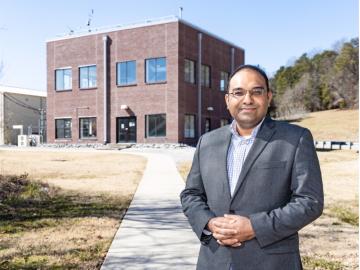
Filter News
Area of Research
- (-) Clean Energy (67)
- (-) Supercomputing (64)
- Advanced Manufacturing (2)
- Biology and Environment (50)
- Biology and Soft Matter (1)
- Building Technologies (3)
- Climate and Environmental Systems (2)
- Computational Engineering (2)
- Computer Science (5)
- Electricity and Smart Grid (1)
- Functional Materials for Energy (1)
- Fusion and Fission (5)
- Fusion Energy (1)
- Isotope Development and Production (1)
- Isotopes (27)
- Materials (54)
- Materials for Computing (3)
- Mathematics (1)
- National Security (20)
- Neutron Science (17)
- Nuclear Science and Technology (10)
- Quantum information Science (1)
News Topics
- (-) Buildings (39)
- (-) Climate Change (35)
- (-) Frontier (29)
- (-) Isotopes (2)
- (-) Machine Learning (19)
- (-) Physics (8)
- (-) Space Exploration (6)
- 3-D Printing/Advanced Manufacturing (80)
- Advanced Reactors (7)
- Artificial Intelligence (41)
- Big Data (24)
- Bioenergy (29)
- Biology (19)
- Biomedical (22)
- Biotechnology (6)
- Chemical Sciences (16)
- Clean Water (8)
- Composites (17)
- Computer Science (107)
- Coronavirus (25)
- Critical Materials (12)
- Cybersecurity (14)
- Decarbonization (35)
- Energy Storage (75)
- Environment (68)
- Exascale Computing (24)
- Fossil Energy (2)
- Fusion (2)
- Grid (42)
- High-Performance Computing (40)
- Hydropower (2)
- Materials (45)
- Materials Science (40)
- Mathematics (3)
- Mercury (3)
- Microelectronics (1)
- Microscopy (14)
- Molten Salt (1)
- Nanotechnology (15)
- National Security (11)
- Net Zero (4)
- Neutron Science (20)
- Nuclear Energy (11)
- Partnerships (12)
- Polymers (13)
- Quantum Computing (19)
- Quantum Science (25)
- Renewable Energy (1)
- Security (9)
- Simulation (17)
- Software (1)
- Statistics (1)
- Summit (43)
- Sustainable Energy (71)
- Transformational Challenge Reactor (3)
- Transportation (70)
Media Contacts

Stephen Kowalski and Mikael Salonvaara received the Distinguished Service Award, which salutes members who have served the society with distinction in chapter, regional and society activities.

Kashif Nawaz, distinguished researcher and section head for Building Technologies Research at the Department of Energy’s Oak Ridge National Laboratory, has been named a Fellow of the American Society of Mechanical Engineers, or ASME.

Nuclear physicists at the Department of Energy’s Oak Ridge National Laboratory recently used Frontier, the world’s most powerful supercomputer, to calculate the magnetic properties of calcium-48’s atomic nucleus.

Researchers from institutions including ORNL have created a new method for statistically analyzing climate models that projects future conditions with more fidelity.

Karen White, who works in ORNL’s Neutron Science Directorate, has been honored with a Lifetime Achievement Award.

ORNL's Climate Change Science Institute and the Georgia Institute of Technology hosted a Southeast Decarbonization Workshop in November that drew scientists and representatives from government, industry, non-profits and other organizations to

Scientists at ORNL used their knowledge of complex ecosystem processes, energy systems, human dynamics, computational science and Earth-scale modeling to inform the nation’s latest National Climate Assessment, which draws attention to vulnerabilities and resilience opportunities in every region of the country.

ORNL researchers demonstrated that an additive made from polymers and electrolytes improves the thermal performance and stability of salt hydrate phase change materials, or PCMs, a finding that could advance their integration into carbon-reducing heat pumps.

The team that built Frontier set out to break the exascale barrier, but the supercomputer’s record-breaking didn’t stop there.

Making room for the world’s first exascale supercomputer took some supersized renovations.


